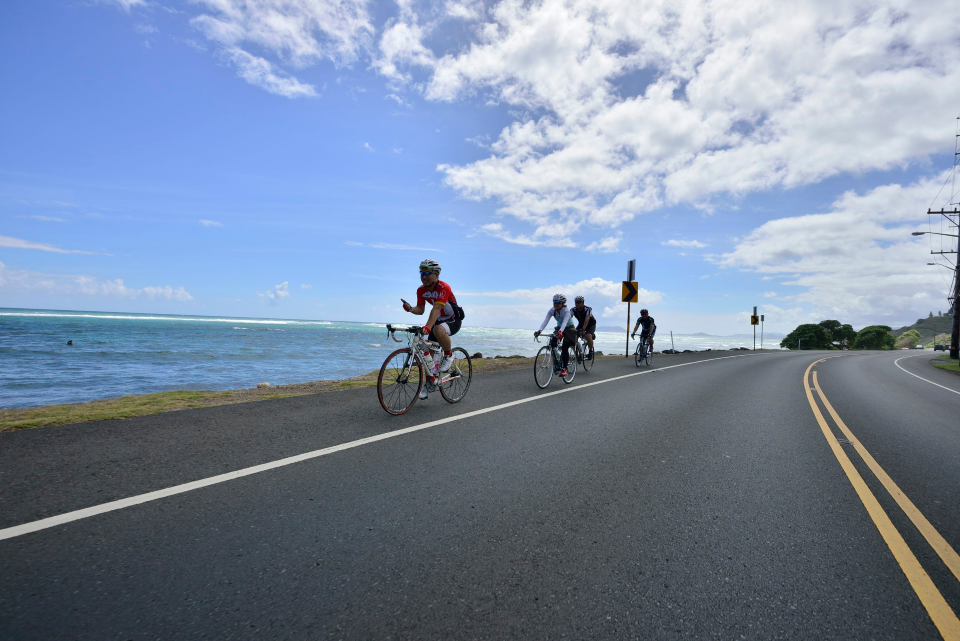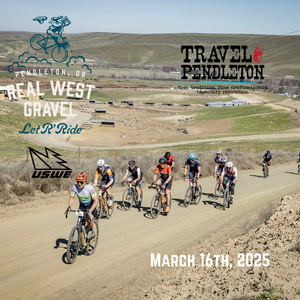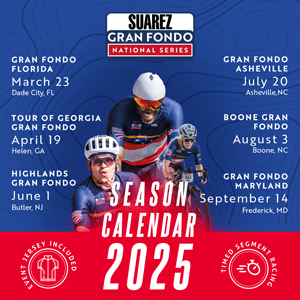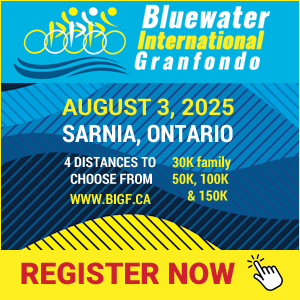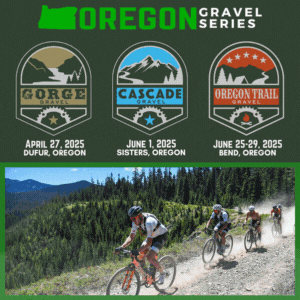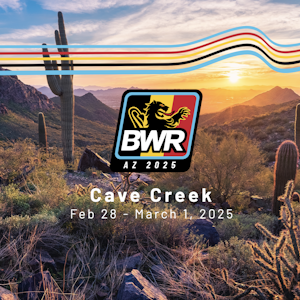Tips for Riding Your First Century
So you've been riding a little or a lot and you've decided to ride your first ride of 100 miles - your first century. You have a ton of questions.
How should I get ready? What do I need to do to my bike? What should I eat? What should I carry? How fast will I go? How much will it hurt?
Anyone can do a century. It takes a little determination and with proper preparation can be relatively painless and quite enjoyable.
Preparing your body for the ride
You may already be ready to ride 100 miles or you may have a long way to go. First you should look at your weekly mileage. Do you even know how much you ride each week? Keeping a log or a riding diary can be invaluable. Use a simple spreadsheet. There are a variety of training diaries available if you want to keep track of more info, like route, speed, temperature, moods, heart rate, etc. Looking back at logs over the years can be entertaining, prompting memories of past rides or simply to track progress or change. .
If you are riding less than 100 miles per week, increase that mileage gradually to at least this level in the weeks prior to the event, trying to ride at least 30 during the week, and 70 on the weekend. Commuting to work or lunch time rides can help you meet that midweek mileage goal. Of course, if you can or want to do more, then do more!
There are many people who believe that you can ride far less than this and still complete the ride. Riders who can't find time during the week can do moderate length rides on weekends and still have hopes of completing a century. I have certainly had my share of times when I only could ride on weekends and did just fine. But ideally one should try to get out a couple of times during the week to keep the muscles loose and in shape. Some form of exercise, even it is only walking midweek is still advisable. The more you ride before the century, the less pain you are likely to experience during and after the ride. Time in the saddle is an important consideration. Getting used to spending the day with the bike will help!
It is entirely possible to go out and ride a century with next to no miles in your legs, if you are determined enough. I have a mailbox full of testimonial to prove it. But you may want to give your bike away at the end of the ride.
Try to increase the length of your longest ride toward the century mark gradually. Don't increase your longest ride from 25 miles to 70 in one week. But do try to do at least a 70 mile ride prior to doing the actual century. Your overall pace on the 70 mile ride should be a good indication of your pace on the century.
Find hills and ride them, especially if you hate hills and don't think you are very good at them. Even if you are doing the Flatter than a Pancake Century, riding hills will make you stronger. And to get stronger on hills, ride more hills.
Get your friends involved. It is always more fun to ride with others, so try to find people to ride with. Make plans to ride with others and stick to it. It's much harder to not go riding if someone is expecting you. The ride will go quicker if you have someone to talk to and you can help each other by drafting when it's windy.
A local bike club is a valuable resource. You will meet many like-minded people. It can also serve as a great source of information about routes, shops, equipment, fit, etc. And if your single, it's a great way to meet other singles! You'll also meet veterans of centuries, who are often full of advice!
Riding with a club will also prepare you for riding in crowds. If you normally ride alone, it can be rather unnerving to be passed by a large peloton doing 30+ mph, or finding yourself in a pack of riders pointing out potholes and glass and such.
Preparing the bike for the ride
Is your bike ready for the ride? Should you use a particular bike for the century?
You don't need to go out and buy a new multi-thousand dollar bike to ride a century. A century really can be comfortably ridden on a mountain bike or a hybrid. Slick narrow tires are available for 26 inch wheels. I wouldn't recommend using 2 inch knobbies on a century, but I'd ride a mountain bike with 1.25 inch slicks without a second thought. I would also probably add some sort of bar ends to increase hand positions if I only had flat bars.
The most important thing is that the bike you ride is comfortable for you. Size does matter. If the stem is too long and it's a real reach to the handlebars, then you will likely end the day with very sore shoulders. If your bike is uncomfortable, then it is probably time to go down to your local shop and get some advice on fit.
Presuming your bike does fit, let's get it ready. Make sure the tires are in good shape and inflated to full pressure. Check the brakes to see that they are properly lined up and work as expected. The pads should hit the center of the rim. They should never touch the tire, or dive under the rim toward the spokes.
Make sure your shifting is working smoothly. If using indexed shifting, does each click change a gear. Depending on what type of levers and derailleurs you have there are various adjusters that allow you to fine tune the indexing. If you don't know how to do this yourself, ask a mechanic at your local shop to show you how.
Check the bottom bracket, headset and wheels. Grab the pedals and try to move them side to side. If you detect motion, your bottom bracket might be loose. Holding the front brake on with the front wheel against a wall, try to rock the bike. If you feel motion, your headset may be loose. Spin the wheel and watch the rim relative to a brake pad, does it stay the same distance from the rim? If not, your wheels are out of true. Have your local shop check over the bike if you suspect a problem with the bottom bracket, headset or wheels.
Are there any loose bolts? Check the water bottle cages, rack, fenders, handlebars, pedals, etc. While doing this make notes about what tools, especially sizes, you need to work on the bike. Note that there are adjustment bolts on derailleurs. These are for fine tuning the indexing and are not a cause of rattle. Do not tighten these (except to adjust indexing). I have heard of folks who tightened every bolt on their bike the night before a ride and then couldn't shift!
If you aren't used to working on your own bike, it's probably a good idea to take your bike into a shop for an overhaul/checkup. Tell them you are planning to do a century, and want the bike ready for the ride. Have this done at least a week before the big ride, so you will have time to get botched repairs corrected. Shops can and do make mistakes.
Check your spare tube. Will it hold air. Some tubes, fresh out of the box may be defective. Check the tube of glue in your patch kit. If it has been opened, it may be all dried up. It's no fun to be on the side of the road with a flat, a tube that won't hold air and a patch kit with no glue.
Clean out your water bottles. Rinse the bottles out thoroughly with bleach, and then rinse the bleach out. Baby bottle cleaner also works well. Standing water, and energy drinks can cause icky things to grow in your bottles over time. Keeping them clean may save you serious stomach ailments on a ride. I also find that adding just a little lemon juice makes warm water go down easier. If it's really hot, a clean wet sock wrapped around the water bottle will help keep the water inside cooler for longer.
It is not a good idea to make major modifications to the bike the day before the ride. This is not the time to try new pedals and change your seat height drastically. If you are planning to make changes, do this well in advance of the event, so that you have plenty of time to get used to them.
Learn to make minor repairs. Everyone should know how to fix a flat. If you don't, ask someone to show you. Someone at your local shop should be willing, when things aren't too busy. Ask them to also show you how to adjust the derailleurs for sloppy indexed shifting and how to prevent overshifting.
Food on the ride
You will need to eat a lot on the ride.
If you are doing an organized ride, they will likely have rest stops with food and water. Check ahead to find out what kind of food they will have and how frequent the stops are. Typical foods on organized centuries include fruit, especially bananas and apples, cookies, peanut butter and jelly sandwiches, peanut butter crackers, fig bars, and bagels. Some rides will have energy bars and sports drinks like Gatorade or Exceed. You may have to depend on stores or carry a lot of your own. The above list is a good list of things to put in your jersey pockets or in a handlebar bag if the ride is not supported. Cycling jerseys, with pockets along the back, are great for carrying food. High sugared candies may give you a temporary boost, but they will also let you down soon after.
Eat before you are hungry and drink before you are thirsty. Carry at least two water bottles, and refill them regularly. Getting dehydrated is one of the most common problems on long rides.
And just let me repeat this for emphasis. Eat Before You Are Hungry And Drink Before You Are Thirsty!
Equipment on the ride
What should you carry?
 Rain Jacket or additional clothing depending on the weather and where the ride is going. If you are climbing a mountain pass, you may need warmer clothing for the top. Check the weather forecast to determine if you will also need arm and legwarmers or full fingered gloves.. I usually use legwarmers if the temperature is below 60F, and I carry them if rain is predicted. They don't take up much space and are easy to add or remove as conditions change. In New England, rain can cause the temps to drop dramatically, and there have been many times that having legwarmers with me has saved me.
Rain Jacket or additional clothing depending on the weather and where the ride is going. If you are climbing a mountain pass, you may need warmer clothing for the top. Check the weather forecast to determine if you will also need arm and legwarmers or full fingered gloves.. I usually use legwarmers if the temperature is below 60F, and I carry them if rain is predicted. They don't take up much space and are easy to add or remove as conditions change. In New England, rain can cause the temps to drop dramatically, and there have been many times that having legwarmers with me has saved me.
 Tools - all the regular stuff, like tubes, tire levers, patch kit, tire boots, a foldable tire, chain break tool, spoke wrench, screwdrivers, hex wrenches and adjustable or box wrenches in the sizes necessary for your bike. As mentioned above, learn how to do minor roadside repairs, and what tools you might need for your bike.
Tools - all the regular stuff, like tubes, tire levers, patch kit, tire boots, a foldable tire, chain break tool, spoke wrench, screwdrivers, hex wrenches and adjustable or box wrenches in the sizes necessary for your bike. As mentioned above, learn how to do minor roadside repairs, and what tools you might need for your bike.
 A foldable tire is not an absolute necessity, especially if you are carrying a tire boot, but it may save time and frustration in event of a bad cut to the tire or sidewall. A tire boot is a 2-3 inch section of old tire with the bead cut off. If you cut your tire all the way through or cut the sidewall, insert this between the tube and the tire. This will prevent the tube from pushing out through the hole and causing more flats. A boot is not noticeable when riding. Really! ($20 bills make good boots too. If you use a $20, you will have the money to buy a new tire when you get to the bike shop!)
A foldable tire is not an absolute necessity, especially if you are carrying a tire boot, but it may save time and frustration in event of a bad cut to the tire or sidewall. A tire boot is a 2-3 inch section of old tire with the bead cut off. If you cut your tire all the way through or cut the sidewall, insert this between the tube and the tire. This will prevent the tube from pushing out through the hole and causing more flats. A boot is not noticeable when riding. Really! ($20 bills make good boots too. If you use a $20, you will have the money to buy a new tire when you get to the bike shop!)
 Map or Cue Sheet and a plastic bag to carry it. If the route is arrowed, you may never have to look at a map or cue sheet. A map is handy if you get off course for finding your way back on the route. A plastic bag or map case will keep it dry and readable. Sweat and rain can make a cue sheet difficult to follow. A handlebar bag will provide a handy place to keep and read a cue.
Map or Cue Sheet and a plastic bag to carry it. If the route is arrowed, you may never have to look at a map or cue sheet. A map is handy if you get off course for finding your way back on the route. A plastic bag or map case will keep it dry and readable. Sweat and rain can make a cue sheet difficult to follow. A handlebar bag will provide a handy place to keep and read a cue.
 Sweatproof sunscreen to be applied during the ride too. Even the sweatproof stuff comes off during a century.
Sweatproof sunscreen to be applied during the ride too. Even the sweatproof stuff comes off during a century.
 Money and Credit Card for food and/or emergencies along the way.
Money and Credit Card for food and/or emergencies along the way.
 Emergency Contact Info and insurance card. First aid items like Band-Aids, neosporin, ibuprofen, and baby wipes might come in handy.
Emergency Contact Info and insurance card. First aid items like Band-Aids, neosporin, ibuprofen, and baby wipes might come in handy.
The actual ride
If it's an organized ride, you may be lucky enough to find a small group to try to ride with. If you haven't already found riding buddies, try to find other people who are riding your pace. You should have determined a comfortable pace on your previous long rides. It's very tempting to start out hard, with a rush of adrenaline and all the other riders around, but try to ride at a steady pace that you can maintain for the whole event. The ride will seem to go by faster with company. When I meet new riders, I ask lots of questions and try to get them to talk and establish a group. You can also help each other out along the way, in case of mechanical problems or physical ones. You can remind each other to eat and drink and encourage each other along the way.
You can try to find an unsuspecting tandem to draft, but as a regular tandem rider I can tell you they aren't unsuspecting! Offering bribes, like lunch may help though!
Try to take short breaks. Several shorts breaks will work better than a few long ones. It's harder to start up after a long break. Try to remember to stretch during these breaks, and while on the bike.
After the ride
Drink plenty of fluids. Get into warm dry clothes. And celebrate with an ice cream sundae or some other high-carb high-fat treat!
You may also want to reward yourself with a massage. Some organized rides will have massage therapists working for a small fee or for free at the end of the ride. If you live in a large town, there may be a massage school, where for a small fee, a student will practice on you.
Then start planning your next one, because you will be hooked!
